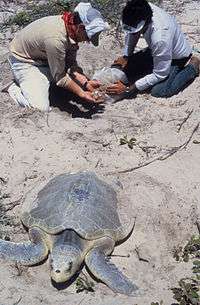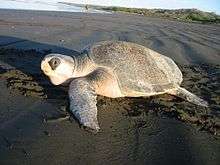Ridley sea turtle
| Ridley sea turtle | |
|---|---|
 | |
| Researchers collect Kemp's ridley sea turtle eggs. | |
| Scientific classification | |
| Kingdom: | Animalia |
| Phylum: | Chordata |
| Class: | Reptilia |
| Order: | Testudines |
| Family: | Cheloniidae |
| Genus: | Lepidochelys Fitzinger, 1843 |
| Species | |
Ridley sea turtles (Lepidochelys) are a genus of sea turtle comprising two species: Kemp's ridley sea turtle and the olive ridley sea turtle.
Kemp's ridley sea turtles are currently on the New York and United States lists of endangered species .
Anatomy
Adult ridley sea turtles grow to a length of 51–71 cm (20–28 in). They have a weight of 36–50 kg (79–110 lb). They feed on crabs, fish, cephalopods, clams, and some marine vegetation.
Etymology and taxonomic history
The etymology of "ridley" is a subject of speculation. Prior to being known as ridleys, the French naturalist Bernard Germain de Lacépède referred to the Lepidochelys species as "bastard turtles". Renowned sea turtle conservationist Archie Carr claimed that "ridley" was a common Floridan term.[1]
Conservation
The Kemp's ridley sea turtle's were on the brink of extinction in the 1960s with low numbers of 200 nesting individuals. Due to strict protection laws that protected their nesting sites in Mexico and altered fishing gear to avoid accidental capture of the Kemp's, the Kemp's ridley numbers have increased to estimated 7000–9000 nesting individuals today. The olive ridley sea turtle is considered to have the most abundant numbers today, estimated as 800,000 nesting individuals. The threats to their survival is loss of nesting habitat, direct harvest of the eggs and adults, and getting caught in fishing gear. Protection of the nesting beaches, changes to the fishing gear, and laws against harvesting the adults and eggs have helped the olive ridley sea turtles numbers gradually increase.

References
- ↑ Dundee, Harold A. (2001). "The Etymological Riddle of the Ridley Sea Turtle". Marine Turtle Newsletter. 58: 10–12. Retrieved 2008-12-30.